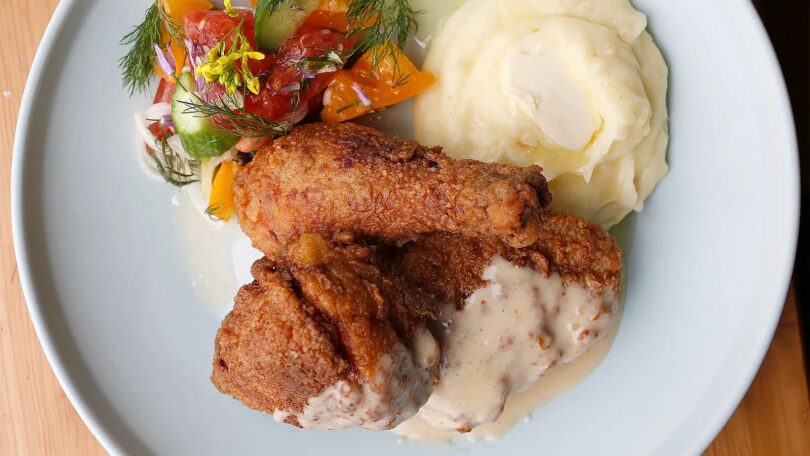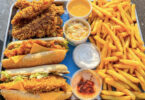Liz Cook
Anyone interested in food as a window to class could do worse than exploring the options available on the RMS Titanic. The handful of menus that survived the wreck reveal important differences in the way the ocean liner’s passengers ate. While third-class passengers dined on rice soup, gruel and cabin biscuits (essentially, a stomach-settling hardtack), first-class diners had a panoply of options.
Now, a first-class dinner menu from the Titanic – from 11 April 1912 – has been sold at an auction held on 11 November at Henry Aldridge & Son in Devizes in Wiltshire, England.
Andrew Aldridge, Managing Director at Henry Aldridge & Son, has more than 25 years of experience valuing and selling Titanic memorabilia. But Aldridge has more than just a business interest in the ocean liner. Like many people, he’s been fascinated with the stories of the Titanic since he was a child; his eighth birthday cake was shaped like the Titanic. And what stands out most to Aldridge is “the breadth and volume of food that was on offer. First-class passengers on the Titanic were extremely well looked after.”
That meant multiple courses, and multiple options for each course. Diners could choose from a menu that might include beef sirloin, spring lamb or duck in a port wine sauce. On 14 April, the infamous day Titanic struck an iceberg, diners had another choice: “chicken à la Maryland”, also known as “Maryland fried chicken”.
“It’s a way of affording status to what is essentially a humble dish,” says Joyce White, a food historian based in Annapolis, Maryland.
Maryland fried chicken – essentially, pan-fried chicken with a cream gravy – didn’t always need the French accent to appeal to the upper class. In the early 19th Century, fried chicken was squarely a special-occasion dish, frequently cooked by enslaved African American women for wealthy Maryland households.
Those same women would often raise chickens and then sell the eggs – sometimes, even to their slaveholders – to trade for goods. “That was a mode of being able to earn some cash or trade for goods that you weren’t allocated,” White says. Slaughtering a young hen for an everyday meal just didn’t make economic sense; the eggs were far more valuable than the meat.
But by the time Maryland fried chicken made its way onboard the Titanic, the rise of the commercial egg industry had changed that calculation. And so fried chicken, too, started to change from a status-connoting dish to more populist picnic fare. It’s no wonder upper-class diners on the Titanic needed the “à la”.
Despite its popularity, tracing Maryland fried chicken back to a single, definitive recipe can be challenging. Even famed culinarian James Beard had difficulty landing on a version to include in his 1972 book, American Cookery. “Strange as it may seem,” Beard wrote in his introduction to the recipe, “no two recipes have any similarity when you compare them.”
Any similarity might be a bit hyperbolic. Most recipes for Maryland fried chicken, past and present, agree on a few basics: the chicken should be dredged in seasoned flour and fried in a cast iron pan – never deep-fried. The pan should be covered with a lid partway through cooking so that the bird essentially steams. And the pan drippings should be whisked into a cream gravy – often a béchamel – either to spoon over the meat or serve alongside.
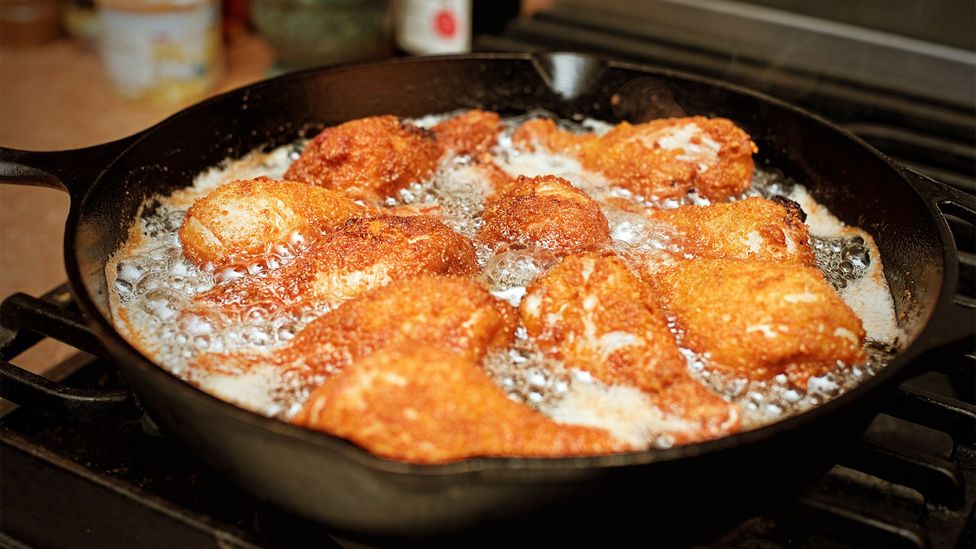
Maryland chicken is dredged in seasoned flour and fried in a cast iron pan (Credit: Stacey Newman)
Maryland fried chicken is a gloriously retro version of fried chicken – one that, until recently, seemed endangered.
“It’s not something that a lot of people make anymore,” says Kara Mae Harris, the author of Old Line Plate: Stories and Recipes from Maryland. “It used to appear in a lot of community cookbooks up through around the 1960s, and then it kind of died out.”
Harris notes that Marylanders can still find that chicken a few places: Gertrude’s, a restaurant inside the Baltimore Museum of Art, serves a “Maryland pan-fried chicken” on Tuesdays, and Baltimore’s Silver Queen Café has a version on its menu, too. But both versions feel more like a throwback than a trend.
That may be changing thanks to chefs like Jared Howard, a native Marylander who operates the fast-casual food stall HoneyBunny in New York City. His specialty? A biscuit sandwich with pan-fried chicken and a shiitake béchamel. Think of it as Maryland fried chicken for a new generation.
Howard took a winding road to culinary entrepreneurship. He started working in restaurants in his mid-30s, balancing a budding interest in cooking with a full-time career in IT. By day, he worked as a corporate cybersecurity professional. By night, he was staging in some of New York’s most prestigious kitchens: The Cecil (temporarily closed), Gotham Bar and Grill and Per Se. Eventually, he was offered a job at Per Se’s sister restaurant, Bouchon, and had to make a tough choice – whether to keep his stable corporate job or go all-in on his dream of becoming an executive chef.
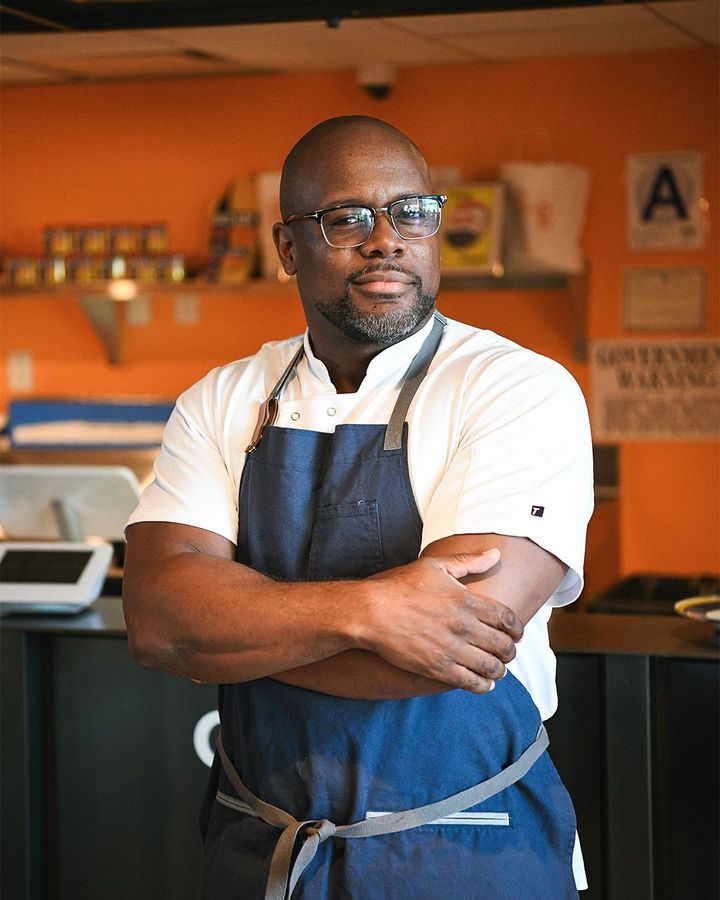
Chef Jared Howard operates the fast-casual food stall HoneyBunny in New York (Credit: Max Flatow)
“I talked to a friend of mine who was in the business, and he said, ‘Jared, you’re too old to be an executive chef. Most people get in this industry when they’re in their teens and twenties, and you’re a 35-year-old line cook. If you want to be an executive chef, you need to own your own restaurant,'” Howard says. “And that was the first time I thought about entrepreneurship as a way to access my dream of cooking and being a chef.”
Howard started digging into Maryland food history, searching for a fruitful personal connection. He found it in Maryland fried chicken. His first foray as a chef-entrepreneur was serving his take on the dish at a pop-up at chef JJ Johnson’s Harlem restaurant, Fieldtrip. That experience spawned another pop-up in Brooklyn – and then, an application with the James Beard Foundation for a six-month business incubator opportunity at Market 57, a food hall at Pier 57 on New York’s Hudson River. Howard is 45 now – and nowhere near aging out of the restaurant business.
At HoneyBunny – Howard’s nickname for his 11-year-old daughter – Howard has reimagined Maryland fried chicken as an accessible, portable dish for a younger and more casual crowd. His signature sandwich is a garlic-buttered biscuit topped with fried chicken, hot sauce, house-cured pickles and a shiitake mushroom béchamel.
That shiitake béchamel is a tribute to the mushroom-soup gravy Howard’s mother would serve over her own fried chicken and rice. But it’s faithful to the broader Maryland fried chicken tradition, too. For her blog, Old Line Plate, Harris uncovered a recipe from the Baltimore & Ohio (B&O) Railroad dining car that that calls for “mushroom essence or puree” in the gravy.
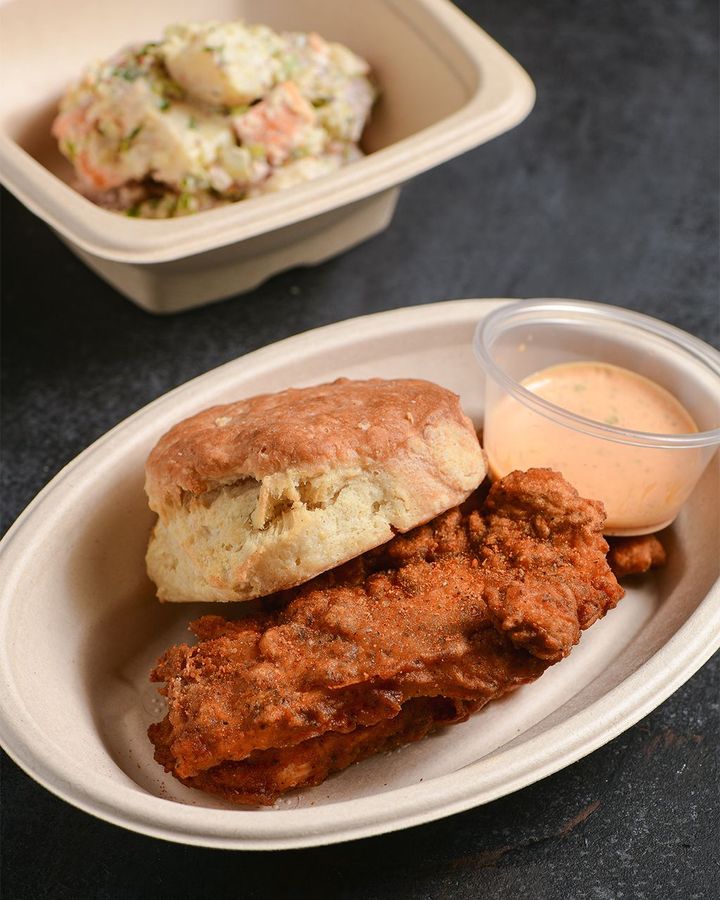
HoneyBunny’s makes a biscuit sandwich with pan-fried chicken and a shiitake bechamel (Credit: Max Flatow)
It’s the kind of chef-y take that might appeal to even the first-class diners on the Titanic, a recipe that Howard is familiar with. His own research suggests the version served to Titanic’s passengers would have featured not a cream gravy but something closer to a velouté (a sauce made from stock, flour, and butter) with white wine.
And if you’ve missed Saturday’s auction of Titanic memorabilia, Howard’s sandwich would make a fine consolation prize. A less expensive one, too. The menu sold for £83,000. By comparison, Howard’s Maryland fried chicken sandwich costs $15 (about £12) – and that includes Old-Bay-seasoned chips and a pickle.
You’ll have to hurry to get that, too. Howard’s residency at Market 57 lasts only six months; his stall will close in March. But he’s hoping to sustain the kind of sales and interest that will allow him to transform HoneyBunny into a permanent stall, if not a standalone brick-and-mortar restaurant. So far, so good. Almost every day, Howard fields questions from curious diners about what distinguishes Maryland fried chicken from its peers. And he has a dozen stories at the ready about the dish and the local and international cooks who cemented its place in the culinary canon.
Stories keep traditions alive – they’re the reason Maryland fried chicken continues to find new fans. They’re the reason why 111 years after the Titanic sank, the ill-fated ocean liner continues to capture our imaginations. They’re the reason a water-logged piece of paper sold on Saturday for the price of a luxury car.
“There were over 2,200 people on that ship,” Aldridge says, “and every man, woman, and child had a story to tell. You had the richest man alive at the time, John Jacob Aster, and you had immigrant families on their way to start a new life. Death shows no bounds with class.”
As it turns out, neither does fried chicken.
Courtesy: BBC

